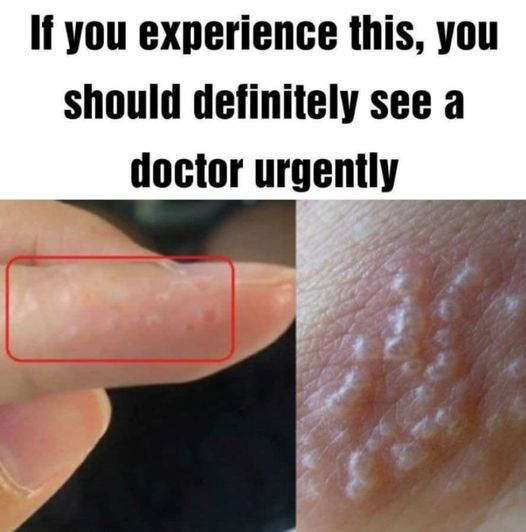As the warm rays of summer approach, many eagerly anticipate days spent basking in the sunshine, indulging in outdoor activities, and soaking up the season’s beauty. But for some, the joys of summer are overshadowed by an unexpected and painful intruder—itchy red bumps that seem to appear out of nowhere, disrupting plans and causing discomfort. If you’ve noticed clusters of these tiny, painful bumps on your fingers, palms, toes, or even the soles of your feet, you might be dealing with more than just a seasonal nuisance. Welcome to the world of dyshidrotic eczema, a condition that can turn your sunny days into a struggle against your own skin.
What Exactly is Dyshidrotic Eczema?

Often mistaken for an allergic reaction or even a heat rash, dyshidrotic eczema is a specific type of eczema that manifests as deep-set, fluid-filled blisters on your extremities. Picture tiny pearls of irritation, itching and burning with a relentless intensity, sometimes making even the simplest of tasks—like holding a pen or tying your shoelaces—feel agonizing. But unlike typical rashes that fade away with time, dyshidrotic eczema is a stubborn condition, requiring ongoing management and care.
This form of eczema tends to make its unwelcome appearance in the spring and summer months, striking when you least expect it. You may start with a mild tingling sensation, only to find small, translucent blisters surfacing soon after. What begins as a minor annoyance can escalate into a full-blown flare-up, with the blisters merging and forming larger, angry patches of skin that may peel, crack, or even ooze. The aftermath? Painful, scaly skin that can take weeks to heal, leaving you frustrated and longing for relief.
Why Does Dyshidrotic Eczema Happen?

You’re probably wondering: what causes this perplexing condition? Unfortunately, like most forms of eczema, the exact cause remains elusive. However, several triggers and risk factors have been identified. Seasonal allergies, stress, and exposure to certain irritants like nickel or cobalt are all known to provoke flare-ups. Even changes in weather can tip the scales, making some individuals more susceptible during specific times of the year.
Interestingly, dyshidrotic eczema runs in families, meaning if your parents or siblings have it, you might be at a higher risk too. And while it can affect anyone, the condition tends to be more common in adults aged 20 to 40, particularly women. Those with a history of other skin conditions, such as atopic dermatitis or hay fever, are also at an increased risk.
But that’s not the end of the story. The condition is known by various names—Pompholyx, Cheiropompholyx, Vesicular Eczema, Foot-and-Hand Eczema, and Dyshidrosis—making it one of the most confusing forms of dermatitis to identify and treat. No matter what it’s called, though, the symptoms remain distressingly the same: intense itching, redness, swelling, and persistent blisters that are as stubborn as they are painful.
Managing Dyshidrotic Eczema: Is There Hope?
So, what can you do if you’re plagued by these pesky blisters? The unfortunate reality is that there’s currently no permanent cure for dyshidrotic eczema. But don’t lose hope just yet! There are numerous strategies that can help manage the condition, reduce flare-ups, and minimize discomfort, allowing you to reclaim control over your skin.
- Medical Treatments: Relief in a Prescription Bottle
In severe cases, your doctor may prescribe corticosteroid creams, injections, or even oral medications to help reduce inflammation and speed up healing. Immune-suppressing ointments, like Protopic and Elidel, may also be used to prevent future outbreaks. For more persistent cases, ultraviolet light therapy has shown promise in calming the overactive immune response that fuels eczema.
And if the blisters are large or filled with fluid, a professional may need to drain them carefully, which can alleviate pain and reduce the risk of infection.
- The Power of Natural Remedies
For those who prefer a more holistic approach, several natural treatments can provide soothing relief:
- Cold Compresses: Applying a cold compress to the affected area for 15-minute intervals a few times a day can ease inflammation and numb the pain. Follow up with a gentle, fragrance-free moisturizer to lock in hydration and prevent further irritation.
- Aloe Vera: Known for its calming and cooling properties, aloe vera gel can be a game-changer. Apply it directly to the blistered areas to reduce swelling and accelerate healing. Choose a natural aloe product or extract the gel directly from the plant for best results.
- Oatmeal Baths: Oatmeal isn’t just a hearty breakfast—it’s a powerhouse of skin-soothing properties. An oatmeal bath or topical oatmeal paste can calm inflamed skin, reducing redness and itching.
- Anticipate and Prevent Flare-Ups
Understanding what triggers your dyshidrotic eczema is half the battle. Avoid known allergens, like nickel-containing jewelry, and try to manage stress levels, as anxiety and tension are common culprits behind sudden flare-ups. Opt for mild, fragrance-free soaps and detergents to avoid aggravating sensitive skin. And, while it may sound counterintuitive, keeping your hands and feet moisturized is essential—even when your skin is blistered. Hydrated skin is less likely to crack and peel, which means less pain and faster recovery.
A Journey of Skin Resilience
Living with dyshidrotic eczema can feel like a constant battle—a battle against your own body and against the urge to scratch at those maddeningly itchy bumps. But with the right management strategies, you can reclaim your comfort and confidence, even during flare-ups. It’s about transforming the narrative from suffering to resilience, from frustration to empowerment.
Every summer doesn’t have to be a season of dread. With proactive care and a bit of planning, you can minimize the impact of this condition and still savor the sunshine. Remember: eczema may be persistent, but so are you.
Wrapping It Up: Share the Knowledge
If you or someone you know is struggling with dyshidrotic eczema, remember that you’re not alone. Millions of people share your experience, and together, we can spread awareness and support. Please SHARE this article with family and friends who might benefit from these insights, and feel free to leave your thoughts and tips in the comments below. Let’s keep the conversation going and help each other find relief!



